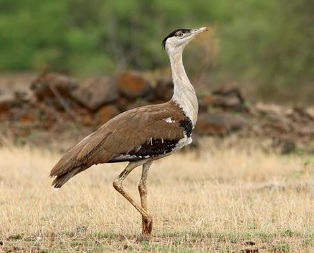Biodiversity & Environment
Great Indian Bustards and Asiatic Lions
- 14 Jun 2023
- 7 min read
For Prelims: Great Indian Bustards, Asiatic Lions,Cyclone Tauktae, Babesiosis, Gir National Park, Kuno National Park, IUCN, WWI
For Mains: Impacts of Natural Disaster in Wildlife Species.
Why in News?
As Cyclone Biporjoy approaches the port of Jakhau in Kutch, Gujarat, there are concerns about the impact on the Great Indian Bustards (GIB) in Naliya region and the Asiatic Lions in the Gir forest.
What are the Concerns?
- Asiatic Lions:
- The Gir forest is home to nearly 700 Asiatic lions, which are found only in this region and are a vital species for conservation.
- Conservationists have raised concerns about the vulnerability of having the entire lion population concentrated in one area. Epidemics and natural disasters like the 2018 outbreak of Babesiosis and Cyclone Tauktae in 2019 pose significant risks to the survival of the lions.
- In 2013, the Supreme Court issued a directive for the transfer of Asiatic lions from Gujarat's Gir forest to Madhya Pradesh's KNP (Kuno National Park).
- The Gujarat government's plea to prevent the translocation of lions was rejected by the court, despite their assertion that these animals were a source of pride for the state.
- In 2013, the Supreme Court issued a directive for the transfer of Asiatic lions from Gujarat's Gir forest to Madhya Pradesh's KNP (Kuno National Park).
- Great Indian Bustard:
- There are only four remaining females in the grasslands of Naliya, Gujarat. As birds, they have better mobility and may be able to sense danger and fly away from the cyclone's path.
- However, the impact on their habitat due to flooding caused by heavy rainfall remains a concern.
- Efforts are being made to ensure the safety of wildlife during the cyclone. The authorities have cancelled leaves, deployed rescue teams, and equipped hospitals to provide medical assistance to injured animals.
What are the Key Points Related to Asiatic Lions?
- About:
- The Asiatic Lion (also known as the Persian Lion or Indian Lion) is a member of the Panthera Leo Leo subspecies that is restricted to India.
- Its previous habitats consisted of West Asia and the Middle East before it became extinct in these regions.
- Asiatic lions are slightly smaller than African lions.
- Distribution:
- Asiatic lions were once distributed to the state of West Bengal in the east and Rewa in Madhya Pradesh, in central India.
- At present Gir National Park and Wildlife Sanctuary is the only abode of the Asiatic lion.
- Protection Status:
- IUCN Red List: Endangered
- CITES: Appendix I
- Wildlife (Protection) Act 1972: Schedule I
Gir National Park
- Gir National Park and Wildlife Sanctuary is located in the Junagadh district of Gujarat.
- It was declared as a sanctuary in 1965 and a national park in 1975.
- The Gir Forests is the largest compact track of dry deciduous forests in the semi-arid western part of India.
- Gir is often linked with "Maldharis" (a traditional pastoral people) who have survived through the ages by having a symbiotic relationship with the lion.
What is the Great Indian Bustard?
- About:
- The Great Indian Bustard (Ardeotis nigriceps), the State bird of Rajasthan, is considered India’s most critically endangered bird.
- It is considered the flagship grassland species, representing the health of the grassland ecology.
- Its population is confined mostly to Rajasthan and Gujarat. Small populations occur in Maharashtra, Karnataka and Andhra Pradesh.
- Vulnerability:
- The bird is under constant threats due to collision/electrocution with power transmission lines, hunting (still prevalent in Pakistan), habitat loss and alteration as a result of widespread agricultural expansion, etc.
- Protection Status:
- IUCN red List: Critically Endangered
- Convention on International Trade in Endangered Species of Wild Fauna and Flora (CITES): Appendix1
- Convention on Migratory Species (CMS): Appendix I
- Wildlife (Protection) Act, 1972: Schedule I
What are the Measures to Protect GIB?
- Species Recovery Programme:
- It is kept under the species recovery programme under the Integrated evelopment of Wildlife Habitats of the Ministry of Environment, Forests and Climate Change (MoEFCC).
- National Bustard Recovery Plans:
- It is currently being implemented by conservation agencies.
- Conservation Breeding Facility:
- MoEF&CC, Rajasthan government and Wildlife Institute of India (WII) have also established a conservation breeding facility in Desert National Park at Jaisalmer in June 2019.
- Project Great Indian Bustard:
- It has been launched by the Rajasthan government with an aim of constructing breeding enclosures for the species and developing infrastructure to reduce human pressure on its habitats.
- Eco-Friendly Measures:
- Task Force for suggesting eco-friendly measures to mitigate impacts of power transmission lines and other power transmission infrastructures on wildlife including the Great Indian Bustard.
UPSC Civil Services Examination Previous Year Question (PYQ)
Q. Consider the following statements: (2019)
- Asiatic lion is naturally found in India only.
- Double-humped camel is naturally found in India only.
- One-horned rhinoceros is naturally found in India only.
Which of the statements given above is/are correct?
(a) 1 only
(b) 2 only
(c) 1 and 3 only
(d) 1, 2 and 3
Ans: (a)
Q. Which one of the following groups of animals belongs to the category of endangered species? (2012)
(a) Great Indian Bustard, Musk Deer, Red Panda and Asiatic Wild Ass
(b) Kashmir Stag, Cheetal, Blue Bull and Great Indian Bustard
(c) Snow Leopard, Swamp Deer, Rhesus Monkey and Saras (Crane)
(d) Lion-tailed Macaque, Blue Bull, Hanuman Langur and Cheetal
Ans: (a)





